Law for Business Managers: Contract, Partnership and Directors' Roles
VerifiedAdded on 2022/02/10
|14
|3819
|24
Report
AI Summary
This report examines key aspects of business law, focusing on the formation of contracts, different types of business structures such as Limited Liability Partnerships (LLPs), and the roles and responsibilities of company directors under UK legislation. The report begins by recommending an LLP for two friends starting an organic vegetable business, highlighting its advantages (ease of formation, tax benefits, management, flexibility) and disadvantages (public records, incorporation costs, legal requirements). It then delves into the legislative provisions regulating LLPs, specifically referencing the Limited Liability Partnership (Application of Companies, 2006) Regulation 2009 and relevant case law. The report also discusses the essential elements of a legally binding contract, including offer, acceptance, consideration, and intention, supported by case law examples such as Walford v Miles and Brogden v Metropolitan Railway. The report provides a comprehensive overview of contract law and business structures, offering valuable insights for business managers.

Law for Business Managers
1
1
Paraphrase This Document
Need a fresh take? Get an instant paraphrase of this document with our AI Paraphraser

Table of Content
Introduction................................................................................................................................3
PART 1.......................................................................................................................................4
PART 2.......................................................................................................................................7
PART 3.....................................................................................................................................10
Conclusion................................................................................................................................12
References................................................................................................................................13
2
Introduction................................................................................................................................3
PART 1.......................................................................................................................................4
PART 2.......................................................................................................................................7
PART 3.....................................................................................................................................10
Conclusion................................................................................................................................12
References................................................................................................................................13
2
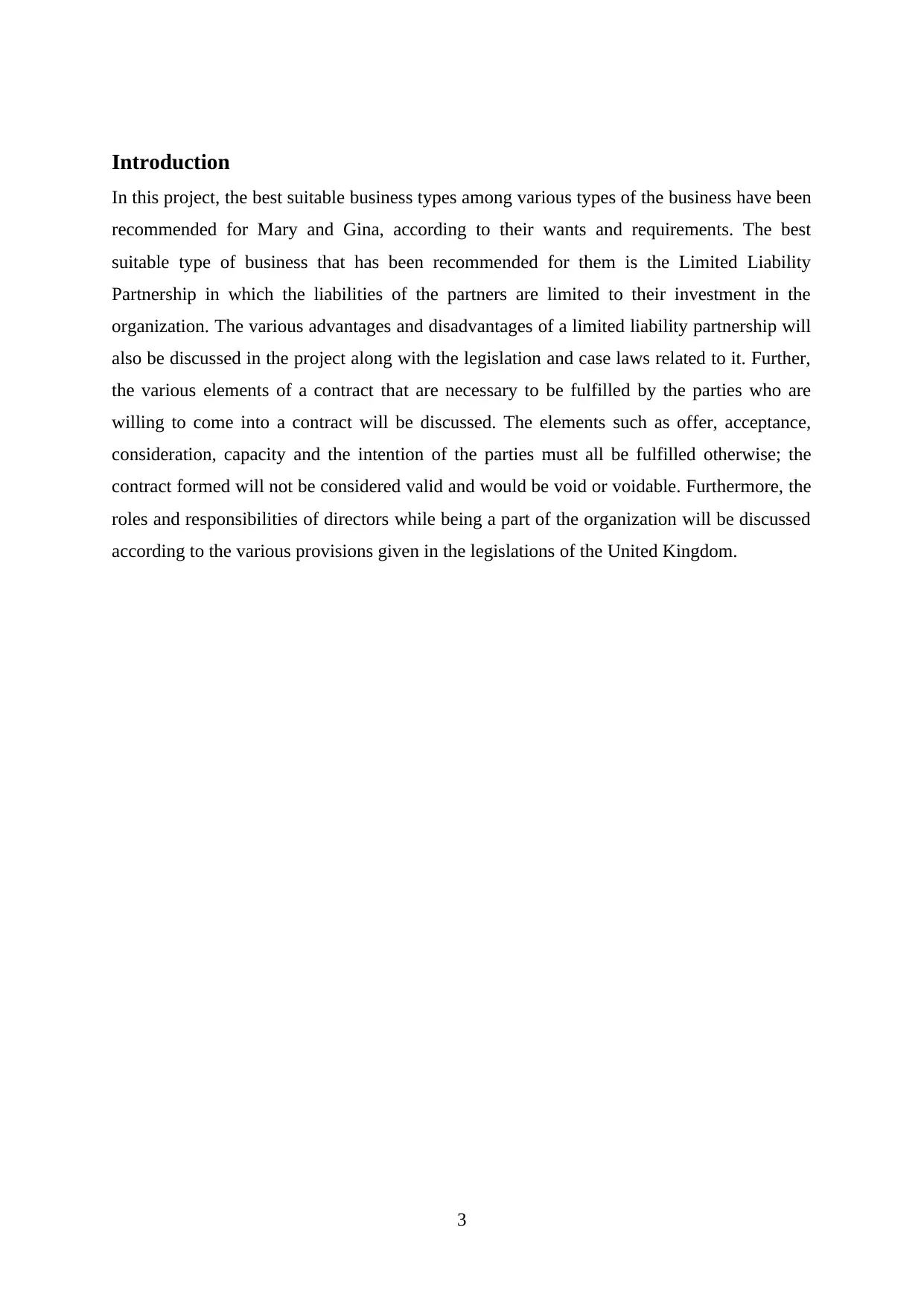
Introduction
In this project, the best suitable business types among various types of the business have been
recommended for Mary and Gina, according to their wants and requirements. The best
suitable type of business that has been recommended for them is the Limited Liability
Partnership in which the liabilities of the partners are limited to their investment in the
organization. The various advantages and disadvantages of a limited liability partnership will
also be discussed in the project along with the legislation and case laws related to it. Further,
the various elements of a contract that are necessary to be fulfilled by the parties who are
willing to come into a contract will be discussed. The elements such as offer, acceptance,
consideration, capacity and the intention of the parties must all be fulfilled otherwise; the
contract formed will not be considered valid and would be void or voidable. Furthermore, the
roles and responsibilities of directors while being a part of the organization will be discussed
according to the various provisions given in the legislations of the United Kingdom.
3
In this project, the best suitable business types among various types of the business have been
recommended for Mary and Gina, according to their wants and requirements. The best
suitable type of business that has been recommended for them is the Limited Liability
Partnership in which the liabilities of the partners are limited to their investment in the
organization. The various advantages and disadvantages of a limited liability partnership will
also be discussed in the project along with the legislation and case laws related to it. Further,
the various elements of a contract that are necessary to be fulfilled by the parties who are
willing to come into a contract will be discussed. The elements such as offer, acceptance,
consideration, capacity and the intention of the parties must all be fulfilled otherwise; the
contract formed will not be considered valid and would be void or voidable. Furthermore, the
roles and responsibilities of directors while being a part of the organization will be discussed
according to the various provisions given in the legislations of the United Kingdom.
3
⊘ This is a preview!⊘
Do you want full access?
Subscribe today to unlock all pages.

Trusted by 1+ million students worldwide
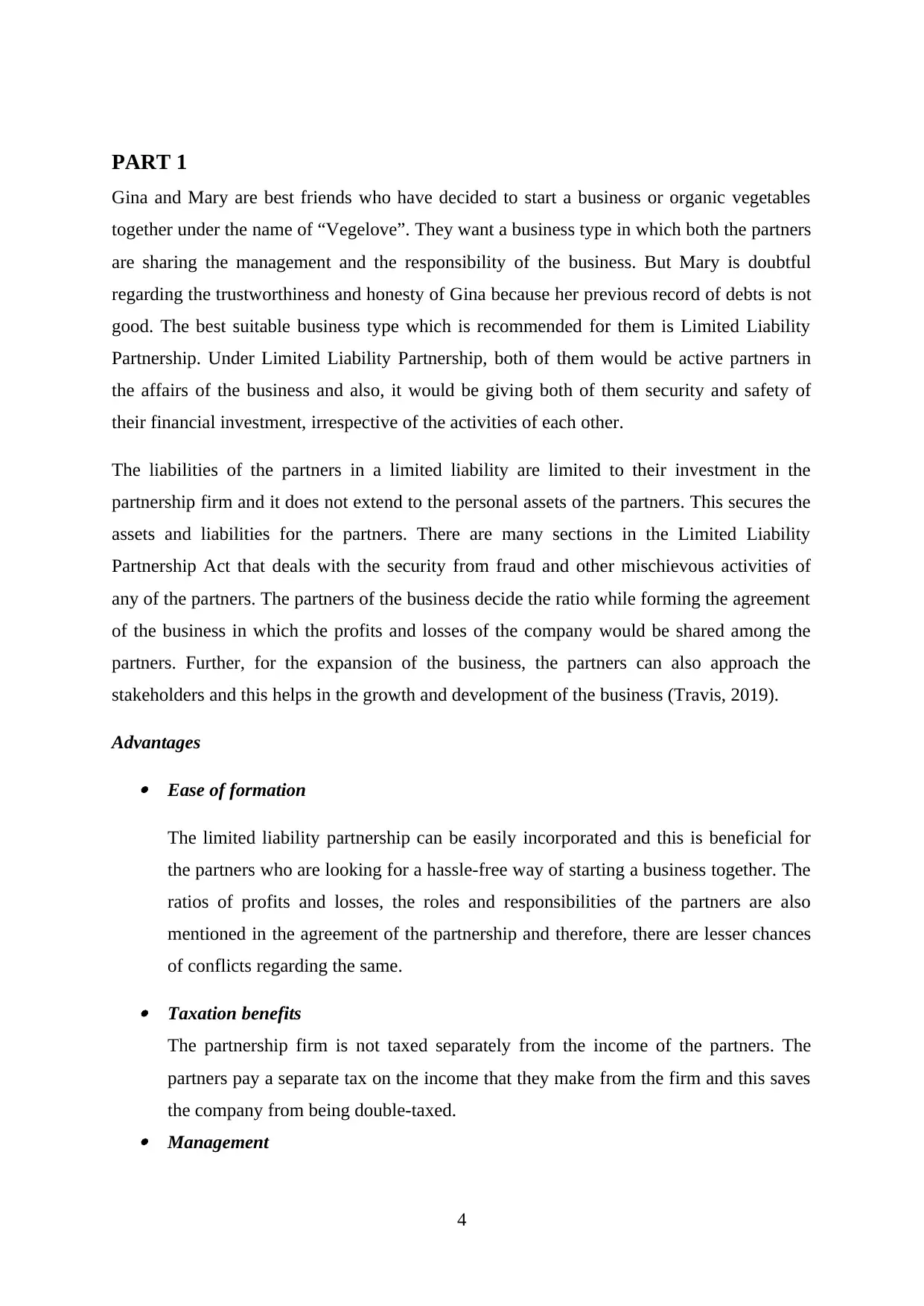
PART 1
Gina and Mary are best friends who have decided to start a business or organic vegetables
together under the name of “Vegelove”. They want a business type in which both the partners
are sharing the management and the responsibility of the business. But Mary is doubtful
regarding the trustworthiness and honesty of Gina because her previous record of debts is not
good. The best suitable business type which is recommended for them is Limited Liability
Partnership. Under Limited Liability Partnership, both of them would be active partners in
the affairs of the business and also, it would be giving both of them security and safety of
their financial investment, irrespective of the activities of each other.
The liabilities of the partners in a limited liability are limited to their investment in the
partnership firm and it does not extend to the personal assets of the partners. This secures the
assets and liabilities for the partners. There are many sections in the Limited Liability
Partnership Act that deals with the security from fraud and other mischievous activities of
any of the partners. The partners of the business decide the ratio while forming the agreement
of the business in which the profits and losses of the company would be shared among the
partners. Further, for the expansion of the business, the partners can also approach the
stakeholders and this helps in the growth and development of the business (Travis, 2019).
Advantages
Ease of formation
The limited liability partnership can be easily incorporated and this is beneficial for
the partners who are looking for a hassle-free way of starting a business together. The
ratios of profits and losses, the roles and responsibilities of the partners are also
mentioned in the agreement of the partnership and therefore, there are lesser chances
of conflicts regarding the same.
Taxation benefits
The partnership firm is not taxed separately from the income of the partners. The
partners pay a separate tax on the income that they make from the firm and this saves
the company from being double-taxed. Management
4
Gina and Mary are best friends who have decided to start a business or organic vegetables
together under the name of “Vegelove”. They want a business type in which both the partners
are sharing the management and the responsibility of the business. But Mary is doubtful
regarding the trustworthiness and honesty of Gina because her previous record of debts is not
good. The best suitable business type which is recommended for them is Limited Liability
Partnership. Under Limited Liability Partnership, both of them would be active partners in
the affairs of the business and also, it would be giving both of them security and safety of
their financial investment, irrespective of the activities of each other.
The liabilities of the partners in a limited liability are limited to their investment in the
partnership firm and it does not extend to the personal assets of the partners. This secures the
assets and liabilities for the partners. There are many sections in the Limited Liability
Partnership Act that deals with the security from fraud and other mischievous activities of
any of the partners. The partners of the business decide the ratio while forming the agreement
of the business in which the profits and losses of the company would be shared among the
partners. Further, for the expansion of the business, the partners can also approach the
stakeholders and this helps in the growth and development of the business (Travis, 2019).
Advantages
Ease of formation
The limited liability partnership can be easily incorporated and this is beneficial for
the partners who are looking for a hassle-free way of starting a business together. The
ratios of profits and losses, the roles and responsibilities of the partners are also
mentioned in the agreement of the partnership and therefore, there are lesser chances
of conflicts regarding the same.
Taxation benefits
The partnership firm is not taxed separately from the income of the partners. The
partners pay a separate tax on the income that they make from the firm and this saves
the company from being double-taxed. Management
4
Paraphrase This Document
Need a fresh take? Get an instant paraphrase of this document with our AI Paraphraser

The partners of the partnership firm share the responsibilities of the business
operations in the way which is mentioned while registering the firm. This ensures that
the burden of management does not fall on any of the partners alone if they do not
wish to. Flexibility
The business operations, as well as the roles of the partners in a limited liability
partnership, are flexible and therefore, the partners have flexible roles in the firm.
This flexibility is useful for the company in making use of various opportunities in the
market (Yu et al., 2018).
Disadvantages
Public records
In a limited liability partnership, the important and valuable records of the firm such
as the financial statements and other records are released for the public and this
hampers the privacy of the organization. The competitors may use the data to gain a
competitive advantage over the company and this can be harmful to the growth of the
company. Cost of Incorporation
The cost which is incurred by the partners in setting up the business in a limited
liability partnership is generally expensive and this also enhances the overall costs of
the company. The profitability in the earlier years of the partnership is expected to be
lower due to the same. Legality
There are many laws and regulations which need to be followed by the company
while carrying out the business operations for the company and this makes the work
hectic for the partners of the firm. This hampers the flexibility of the operations of the
company as well (Kurnianto et al., 2019).
Mary and Gina must go through all these advantages and disadvantages before they decide to
enter into a limited liability partnership. Extensive research of the same would help them in
understanding what their requirements from the same are and how they can align their goals
and targets with the company and its business operations.
Legislative provisions applied on a limited liability partnership
5
operations in the way which is mentioned while registering the firm. This ensures that
the burden of management does not fall on any of the partners alone if they do not
wish to. Flexibility
The business operations, as well as the roles of the partners in a limited liability
partnership, are flexible and therefore, the partners have flexible roles in the firm.
This flexibility is useful for the company in making use of various opportunities in the
market (Yu et al., 2018).
Disadvantages
Public records
In a limited liability partnership, the important and valuable records of the firm such
as the financial statements and other records are released for the public and this
hampers the privacy of the organization. The competitors may use the data to gain a
competitive advantage over the company and this can be harmful to the growth of the
company. Cost of Incorporation
The cost which is incurred by the partners in setting up the business in a limited
liability partnership is generally expensive and this also enhances the overall costs of
the company. The profitability in the earlier years of the partnership is expected to be
lower due to the same. Legality
There are many laws and regulations which need to be followed by the company
while carrying out the business operations for the company and this makes the work
hectic for the partners of the firm. This hampers the flexibility of the operations of the
company as well (Kurnianto et al., 2019).
Mary and Gina must go through all these advantages and disadvantages before they decide to
enter into a limited liability partnership. Extensive research of the same would help them in
understanding what their requirements from the same are and how they can align their goals
and targets with the company and its business operations.
Legislative provisions applied on a limited liability partnership
5
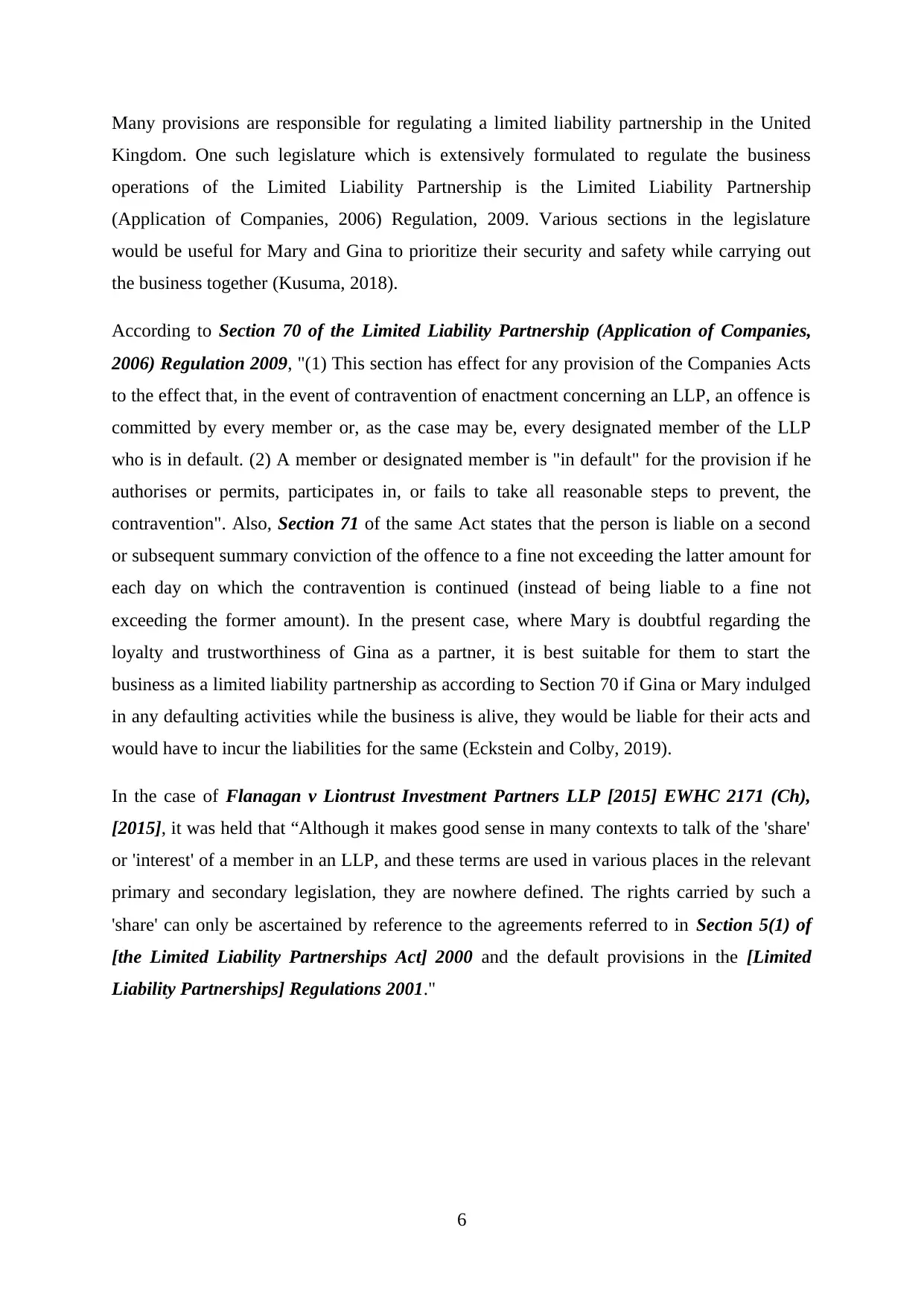
Many provisions are responsible for regulating a limited liability partnership in the United
Kingdom. One such legislature which is extensively formulated to regulate the business
operations of the Limited Liability Partnership is the Limited Liability Partnership
(Application of Companies, 2006) Regulation, 2009. Various sections in the legislature
would be useful for Mary and Gina to prioritize their security and safety while carrying out
the business together (Kusuma, 2018).
According to Section 70 of the Limited Liability Partnership (Application of Companies,
2006) Regulation 2009, "(1) This section has effect for any provision of the Companies Acts
to the effect that, in the event of contravention of enactment concerning an LLP, an offence is
committed by every member or, as the case may be, every designated member of the LLP
who is in default. (2) A member or designated member is "in default" for the provision if he
authorises or permits, participates in, or fails to take all reasonable steps to prevent, the
contravention". Also, Section 71 of the same Act states that the person is liable on a second
or subsequent summary conviction of the offence to a fine not exceeding the latter amount for
each day on which the contravention is continued (instead of being liable to a fine not
exceeding the former amount). In the present case, where Mary is doubtful regarding the
loyalty and trustworthiness of Gina as a partner, it is best suitable for them to start the
business as a limited liability partnership as according to Section 70 if Gina or Mary indulged
in any defaulting activities while the business is alive, they would be liable for their acts and
would have to incur the liabilities for the same (Eckstein and Colby, 2019).
In the case of Flanagan v Liontrust Investment Partners LLP [2015] EWHC 2171 (Ch),
[2015], it was held that “Although it makes good sense in many contexts to talk of the 'share'
or 'interest' of a member in an LLP, and these terms are used in various places in the relevant
primary and secondary legislation, they are nowhere defined. The rights carried by such a
'share' can only be ascertained by reference to the agreements referred to in Section 5(1) of
[the Limited Liability Partnerships Act] 2000 and the default provisions in the [Limited
Liability Partnerships] Regulations 2001."
6
Kingdom. One such legislature which is extensively formulated to regulate the business
operations of the Limited Liability Partnership is the Limited Liability Partnership
(Application of Companies, 2006) Regulation, 2009. Various sections in the legislature
would be useful for Mary and Gina to prioritize their security and safety while carrying out
the business together (Kusuma, 2018).
According to Section 70 of the Limited Liability Partnership (Application of Companies,
2006) Regulation 2009, "(1) This section has effect for any provision of the Companies Acts
to the effect that, in the event of contravention of enactment concerning an LLP, an offence is
committed by every member or, as the case may be, every designated member of the LLP
who is in default. (2) A member or designated member is "in default" for the provision if he
authorises or permits, participates in, or fails to take all reasonable steps to prevent, the
contravention". Also, Section 71 of the same Act states that the person is liable on a second
or subsequent summary conviction of the offence to a fine not exceeding the latter amount for
each day on which the contravention is continued (instead of being liable to a fine not
exceeding the former amount). In the present case, where Mary is doubtful regarding the
loyalty and trustworthiness of Gina as a partner, it is best suitable for them to start the
business as a limited liability partnership as according to Section 70 if Gina or Mary indulged
in any defaulting activities while the business is alive, they would be liable for their acts and
would have to incur the liabilities for the same (Eckstein and Colby, 2019).
In the case of Flanagan v Liontrust Investment Partners LLP [2015] EWHC 2171 (Ch),
[2015], it was held that “Although it makes good sense in many contexts to talk of the 'share'
or 'interest' of a member in an LLP, and these terms are used in various places in the relevant
primary and secondary legislation, they are nowhere defined. The rights carried by such a
'share' can only be ascertained by reference to the agreements referred to in Section 5(1) of
[the Limited Liability Partnerships Act] 2000 and the default provisions in the [Limited
Liability Partnerships] Regulations 2001."
6
⊘ This is a preview!⊘
Do you want full access?
Subscribe today to unlock all pages.

Trusted by 1+ million students worldwide
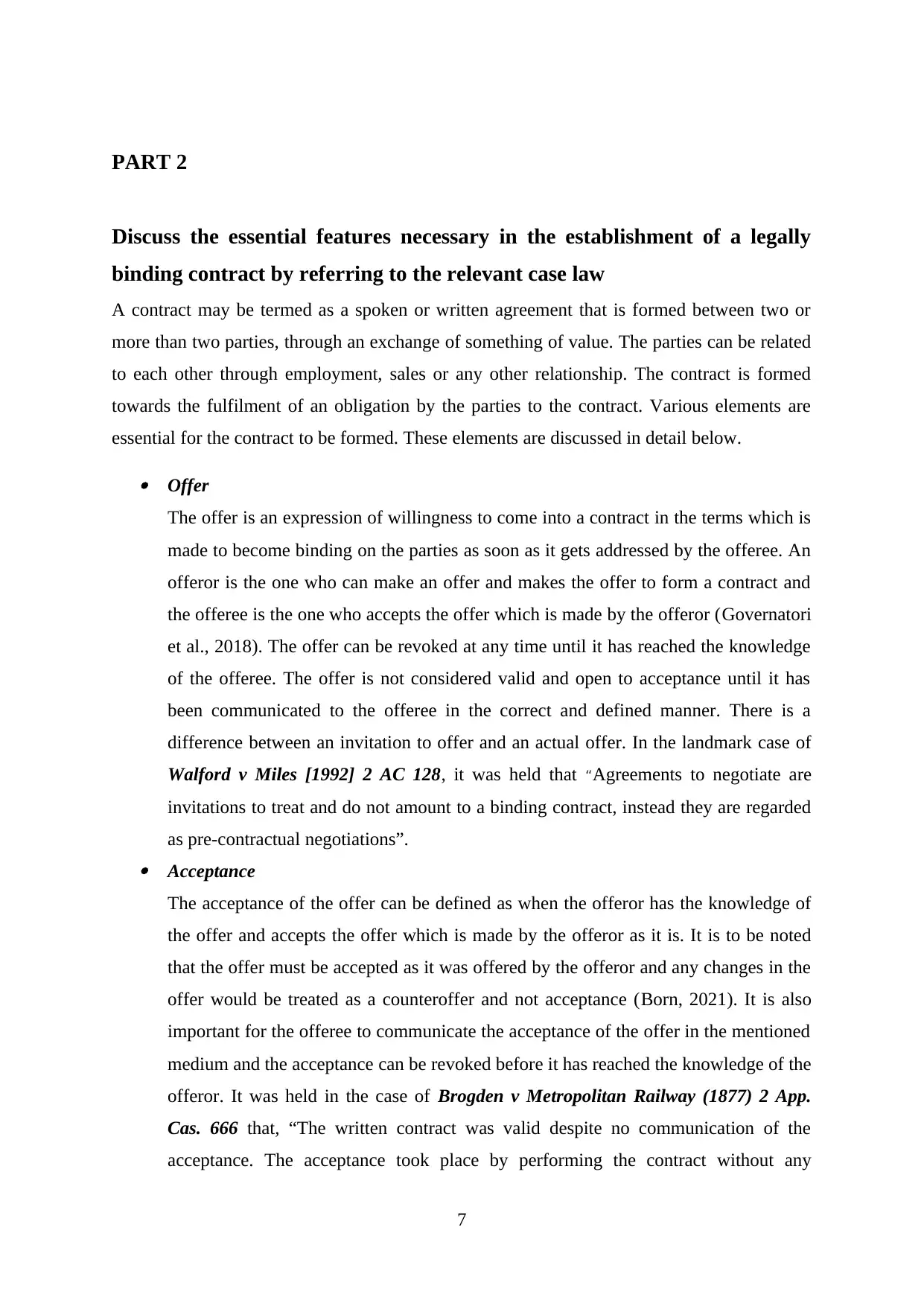
PART 2
Discuss the essential features necessary in the establishment of a legally
binding contract by referring to the relevant case law
A contract may be termed as a spoken or written agreement that is formed between two or
more than two parties, through an exchange of something of value. The parties can be related
to each other through employment, sales or any other relationship. The contract is formed
towards the fulfilment of an obligation by the parties to the contract. Various elements are
essential for the contract to be formed. These elements are discussed in detail below.
Offer
The offer is an expression of willingness to come into a contract in the terms which is
made to become binding on the parties as soon as it gets addressed by the offeree. An
offeror is the one who can make an offer and makes the offer to form a contract and
the offeree is the one who accepts the offer which is made by the offeror (Governatori
et al., 2018). The offer can be revoked at any time until it has reached the knowledge
of the offeree. The offer is not considered valid and open to acceptance until it has
been communicated to the offeree in the correct and defined manner. There is a
difference between an invitation to offer and an actual offer. In the landmark case of
Walford v Miles [1992] 2 AC 128, it was held that “Agreements to negotiate are
invitations to treat and do not amount to a binding contract, instead they are regarded
as pre-contractual negotiations”. Acceptance
The acceptance of the offer can be defined as when the offeror has the knowledge of
the offer and accepts the offer which is made by the offeror as it is. It is to be noted
that the offer must be accepted as it was offered by the offeror and any changes in the
offer would be treated as a counteroffer and not acceptance (Born, 2021). It is also
important for the offeree to communicate the acceptance of the offer in the mentioned
medium and the acceptance can be revoked before it has reached the knowledge of the
offeror. It was held in the case of Brogden v Metropolitan Railway (1877) 2 App.
Cas. 666 that, “The written contract was valid despite no communication of the
acceptance. The acceptance took place by performing the contract without any
7
Discuss the essential features necessary in the establishment of a legally
binding contract by referring to the relevant case law
A contract may be termed as a spoken or written agreement that is formed between two or
more than two parties, through an exchange of something of value. The parties can be related
to each other through employment, sales or any other relationship. The contract is formed
towards the fulfilment of an obligation by the parties to the contract. Various elements are
essential for the contract to be formed. These elements are discussed in detail below.
Offer
The offer is an expression of willingness to come into a contract in the terms which is
made to become binding on the parties as soon as it gets addressed by the offeree. An
offeror is the one who can make an offer and makes the offer to form a contract and
the offeree is the one who accepts the offer which is made by the offeror (Governatori
et al., 2018). The offer can be revoked at any time until it has reached the knowledge
of the offeree. The offer is not considered valid and open to acceptance until it has
been communicated to the offeree in the correct and defined manner. There is a
difference between an invitation to offer and an actual offer. In the landmark case of
Walford v Miles [1992] 2 AC 128, it was held that “Agreements to negotiate are
invitations to treat and do not amount to a binding contract, instead they are regarded
as pre-contractual negotiations”. Acceptance
The acceptance of the offer can be defined as when the offeror has the knowledge of
the offer and accepts the offer which is made by the offeror as it is. It is to be noted
that the offer must be accepted as it was offered by the offeror and any changes in the
offer would be treated as a counteroffer and not acceptance (Born, 2021). It is also
important for the offeree to communicate the acceptance of the offer in the mentioned
medium and the acceptance can be revoked before it has reached the knowledge of the
offeror. It was held in the case of Brogden v Metropolitan Railway (1877) 2 App.
Cas. 666 that, “The written contract was valid despite no communication of the
acceptance. The acceptance took place by performing the contract without any
7
Paraphrase This Document
Need a fresh take? Get an instant paraphrase of this document with our AI Paraphraser
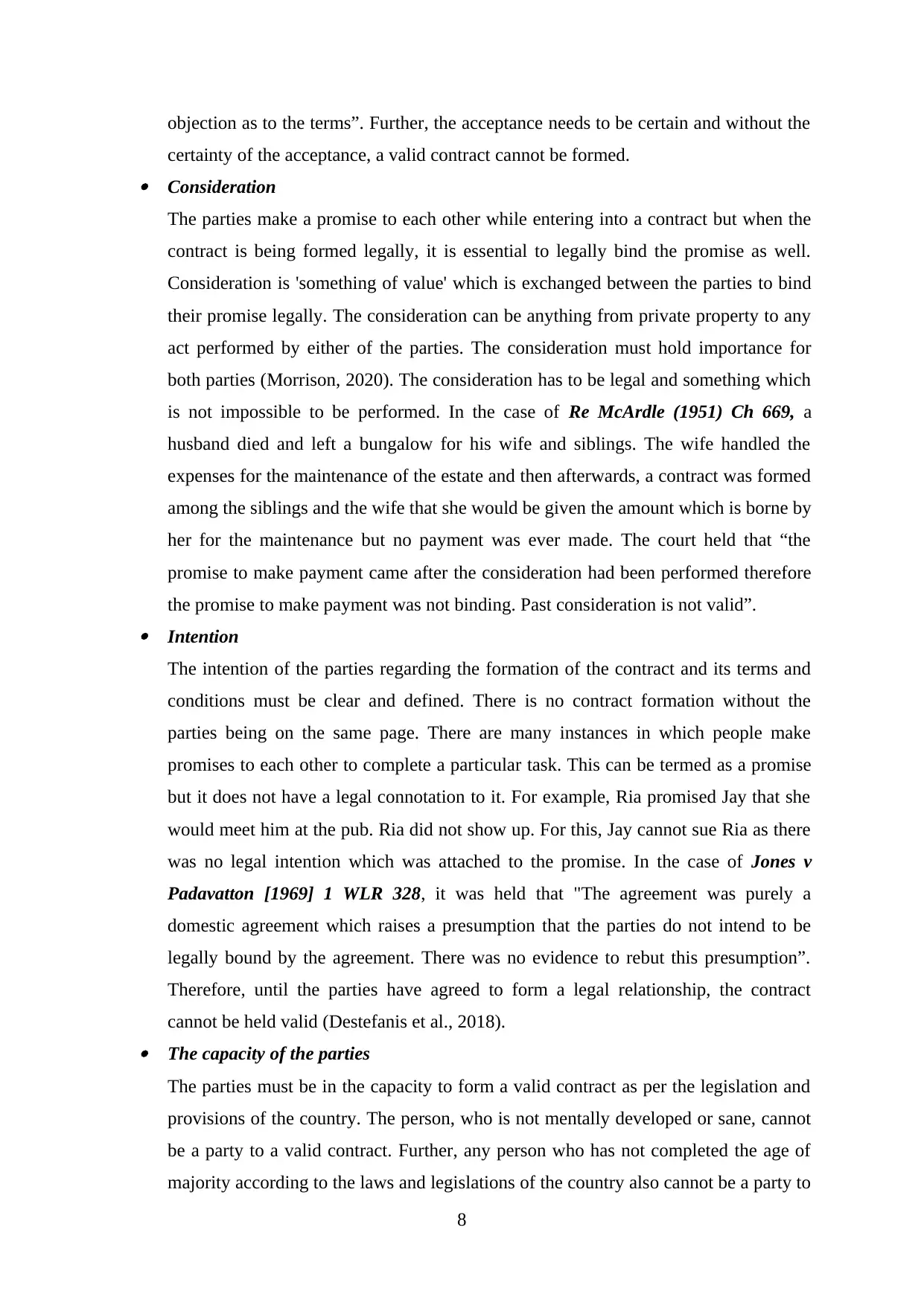
objection as to the terms”. Further, the acceptance needs to be certain and without the
certainty of the acceptance, a valid contract cannot be formed. Consideration
The parties make a promise to each other while entering into a contract but when the
contract is being formed legally, it is essential to legally bind the promise as well.
Consideration is 'something of value' which is exchanged between the parties to bind
their promise legally. The consideration can be anything from private property to any
act performed by either of the parties. The consideration must hold importance for
both parties (Morrison, 2020). The consideration has to be legal and something which
is not impossible to be performed. In the case of Re McArdle (1951) Ch 669, a
husband died and left a bungalow for his wife and siblings. The wife handled the
expenses for the maintenance of the estate and then afterwards, a contract was formed
among the siblings and the wife that she would be given the amount which is borne by
her for the maintenance but no payment was ever made. The court held that “the
promise to make payment came after the consideration had been performed therefore
the promise to make payment was not binding. Past consideration is not valid”. Intention
The intention of the parties regarding the formation of the contract and its terms and
conditions must be clear and defined. There is no contract formation without the
parties being on the same page. There are many instances in which people make
promises to each other to complete a particular task. This can be termed as a promise
but it does not have a legal connotation to it. For example, Ria promised Jay that she
would meet him at the pub. Ria did not show up. For this, Jay cannot sue Ria as there
was no legal intention which was attached to the promise. In the case of Jones v
Padavatton [1969] 1 WLR 328, it was held that "The agreement was purely a
domestic agreement which raises a presumption that the parties do not intend to be
legally bound by the agreement. There was no evidence to rebut this presumption”.
Therefore, until the parties have agreed to form a legal relationship, the contract
cannot be held valid (Destefanis et al., 2018). The capacity of the parties
The parties must be in the capacity to form a valid contract as per the legislation and
provisions of the country. The person, who is not mentally developed or sane, cannot
be a party to a valid contract. Further, any person who has not completed the age of
majority according to the laws and legislations of the country also cannot be a party to
8
certainty of the acceptance, a valid contract cannot be formed. Consideration
The parties make a promise to each other while entering into a contract but when the
contract is being formed legally, it is essential to legally bind the promise as well.
Consideration is 'something of value' which is exchanged between the parties to bind
their promise legally. The consideration can be anything from private property to any
act performed by either of the parties. The consideration must hold importance for
both parties (Morrison, 2020). The consideration has to be legal and something which
is not impossible to be performed. In the case of Re McArdle (1951) Ch 669, a
husband died and left a bungalow for his wife and siblings. The wife handled the
expenses for the maintenance of the estate and then afterwards, a contract was formed
among the siblings and the wife that she would be given the amount which is borne by
her for the maintenance but no payment was ever made. The court held that “the
promise to make payment came after the consideration had been performed therefore
the promise to make payment was not binding. Past consideration is not valid”. Intention
The intention of the parties regarding the formation of the contract and its terms and
conditions must be clear and defined. There is no contract formation without the
parties being on the same page. There are many instances in which people make
promises to each other to complete a particular task. This can be termed as a promise
but it does not have a legal connotation to it. For example, Ria promised Jay that she
would meet him at the pub. Ria did not show up. For this, Jay cannot sue Ria as there
was no legal intention which was attached to the promise. In the case of Jones v
Padavatton [1969] 1 WLR 328, it was held that "The agreement was purely a
domestic agreement which raises a presumption that the parties do not intend to be
legally bound by the agreement. There was no evidence to rebut this presumption”.
Therefore, until the parties have agreed to form a legal relationship, the contract
cannot be held valid (Destefanis et al., 2018). The capacity of the parties
The parties must be in the capacity to form a valid contract as per the legislation and
provisions of the country. The person, who is not mentally developed or sane, cannot
be a party to a valid contract. Further, any person who has not completed the age of
majority according to the laws and legislations of the country also cannot be a party to
8

a valid contract. This is done so that the person who is forming the contract has the
knowledge and understanding of the contract and its consequences. Any person who
is under the influence of alcohol or any other intoxication is also prohibited to enter
into the contract while they are intoxicated. A person who is partially insane can come
into the contract in the interval when he is sane (Knapp et al., 2019).
9
knowledge and understanding of the contract and its consequences. Any person who
is under the influence of alcohol or any other intoxication is also prohibited to enter
into the contract while they are intoxicated. A person who is partially insane can come
into the contract in the interval when he is sane (Knapp et al., 2019).
9
⊘ This is a preview!⊘
Do you want full access?
Subscribe today to unlock all pages.

Trusted by 1+ million students worldwide
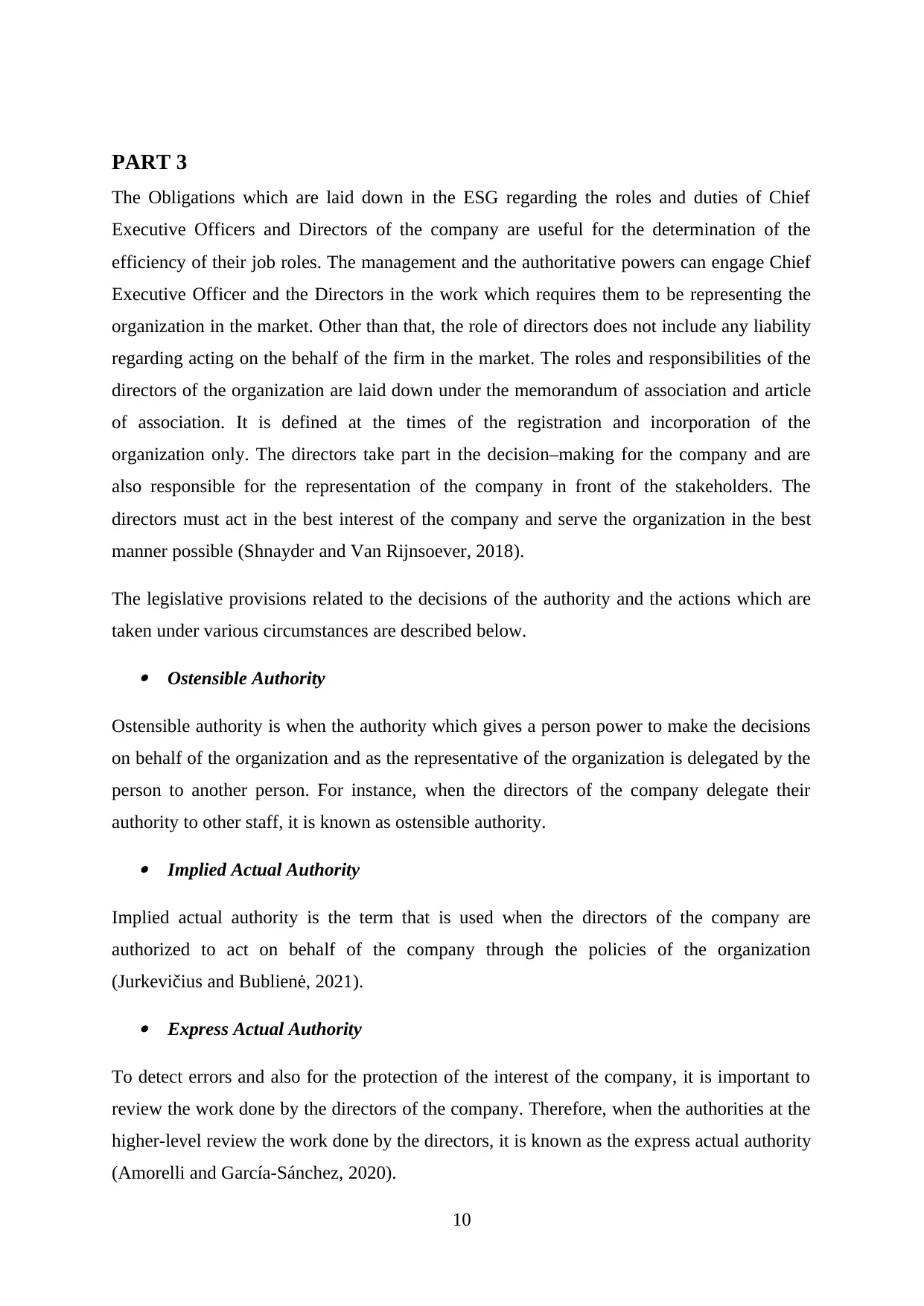
PART 3
The Obligations which are laid down in the ESG regarding the roles and duties of Chief
Executive Officers and Directors of the company are useful for the determination of the
efficiency of their job roles. The management and the authoritative powers can engage Chief
Executive Officer and the Directors in the work which requires them to be representing the
organization in the market. Other than that, the role of directors does not include any liability
regarding acting on the behalf of the firm in the market. The roles and responsibilities of the
directors of the organization are laid down under the memorandum of association and article
of association. It is defined at the times of the registration and incorporation of the
organization only. The directors take part in the decision–making for the company and are
also responsible for the representation of the company in front of the stakeholders. The
directors must act in the best interest of the company and serve the organization in the best
manner possible (Shnayder and Van Rijnsoever, 2018).
The legislative provisions related to the decisions of the authority and the actions which are
taken under various circumstances are described below.
Ostensible Authority
Ostensible authority is when the authority which gives a person power to make the decisions
on behalf of the organization and as the representative of the organization is delegated by the
person to another person. For instance, when the directors of the company delegate their
authority to other staff, it is known as ostensible authority.
Implied Actual Authority
Implied actual authority is the term that is used when the directors of the company are
authorized to act on behalf of the company through the policies of the organization
(Jurkevičius and Bublienė, 2021).
Express Actual Authority
To detect errors and also for the protection of the interest of the company, it is important to
review the work done by the directors of the company. Therefore, when the authorities at the
higher-level review the work done by the directors, it is known as the express actual authority
(Amorelli and García‐Sánchez, 2020).
10
The Obligations which are laid down in the ESG regarding the roles and duties of Chief
Executive Officers and Directors of the company are useful for the determination of the
efficiency of their job roles. The management and the authoritative powers can engage Chief
Executive Officer and the Directors in the work which requires them to be representing the
organization in the market. Other than that, the role of directors does not include any liability
regarding acting on the behalf of the firm in the market. The roles and responsibilities of the
directors of the organization are laid down under the memorandum of association and article
of association. It is defined at the times of the registration and incorporation of the
organization only. The directors take part in the decision–making for the company and are
also responsible for the representation of the company in front of the stakeholders. The
directors must act in the best interest of the company and serve the organization in the best
manner possible (Shnayder and Van Rijnsoever, 2018).
The legislative provisions related to the decisions of the authority and the actions which are
taken under various circumstances are described below.
Ostensible Authority
Ostensible authority is when the authority which gives a person power to make the decisions
on behalf of the organization and as the representative of the organization is delegated by the
person to another person. For instance, when the directors of the company delegate their
authority to other staff, it is known as ostensible authority.
Implied Actual Authority
Implied actual authority is the term that is used when the directors of the company are
authorized to act on behalf of the company through the policies of the organization
(Jurkevičius and Bublienė, 2021).
Express Actual Authority
To detect errors and also for the protection of the interest of the company, it is important to
review the work done by the directors of the company. Therefore, when the authorities at the
higher-level review the work done by the directors, it is known as the express actual authority
(Amorelli and García‐Sánchez, 2020).
10
Paraphrase This Document
Need a fresh take? Get an instant paraphrase of this document with our AI Paraphraser
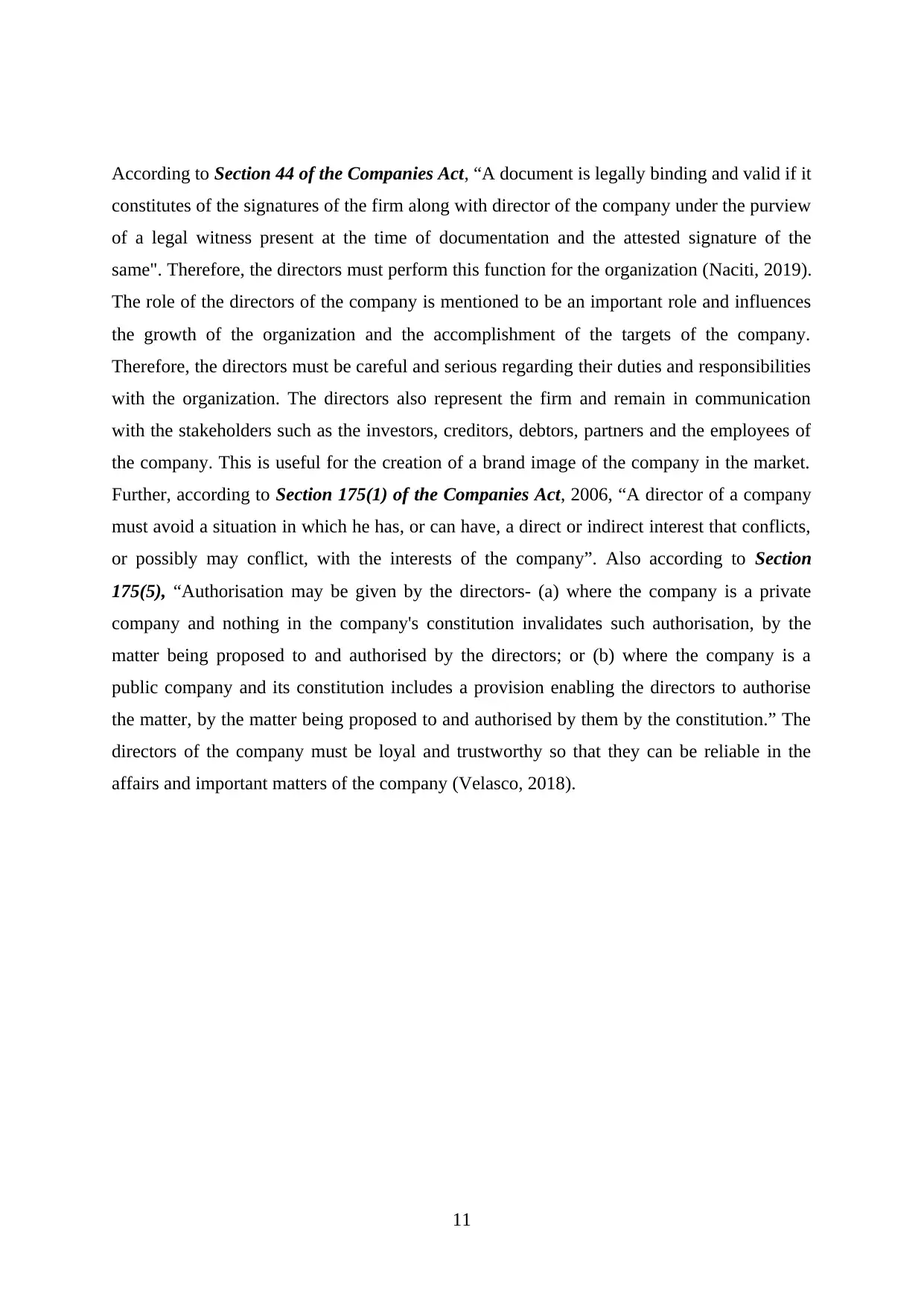
According to Section 44 of the Companies Act, “A document is legally binding and valid if it
constitutes of the signatures of the firm along with director of the company under the purview
of a legal witness present at the time of documentation and the attested signature of the
same". Therefore, the directors must perform this function for the organization (Naciti, 2019).
The role of the directors of the company is mentioned to be an important role and influences
the growth of the organization and the accomplishment of the targets of the company.
Therefore, the directors must be careful and serious regarding their duties and responsibilities
with the organization. The directors also represent the firm and remain in communication
with the stakeholders such as the investors, creditors, debtors, partners and the employees of
the company. This is useful for the creation of a brand image of the company in the market.
Further, according to Section 175(1) of the Companies Act, 2006, “A director of a company
must avoid a situation in which he has, or can have, a direct or indirect interest that conflicts,
or possibly may conflict, with the interests of the company”. Also according to Section
175(5), “Authorisation may be given by the directors- (a) where the company is a private
company and nothing in the company's constitution invalidates such authorisation, by the
matter being proposed to and authorised by the directors; or (b) where the company is a
public company and its constitution includes a provision enabling the directors to authorise
the matter, by the matter being proposed to and authorised by them by the constitution.” The
directors of the company must be loyal and trustworthy so that they can be reliable in the
affairs and important matters of the company (Velasco, 2018).
11
constitutes of the signatures of the firm along with director of the company under the purview
of a legal witness present at the time of documentation and the attested signature of the
same". Therefore, the directors must perform this function for the organization (Naciti, 2019).
The role of the directors of the company is mentioned to be an important role and influences
the growth of the organization and the accomplishment of the targets of the company.
Therefore, the directors must be careful and serious regarding their duties and responsibilities
with the organization. The directors also represent the firm and remain in communication
with the stakeholders such as the investors, creditors, debtors, partners and the employees of
the company. This is useful for the creation of a brand image of the company in the market.
Further, according to Section 175(1) of the Companies Act, 2006, “A director of a company
must avoid a situation in which he has, or can have, a direct or indirect interest that conflicts,
or possibly may conflict, with the interests of the company”. Also according to Section
175(5), “Authorisation may be given by the directors- (a) where the company is a private
company and nothing in the company's constitution invalidates such authorisation, by the
matter being proposed to and authorised by the directors; or (b) where the company is a
public company and its constitution includes a provision enabling the directors to authorise
the matter, by the matter being proposed to and authorised by them by the constitution.” The
directors of the company must be loyal and trustworthy so that they can be reliable in the
affairs and important matters of the company (Velasco, 2018).
11
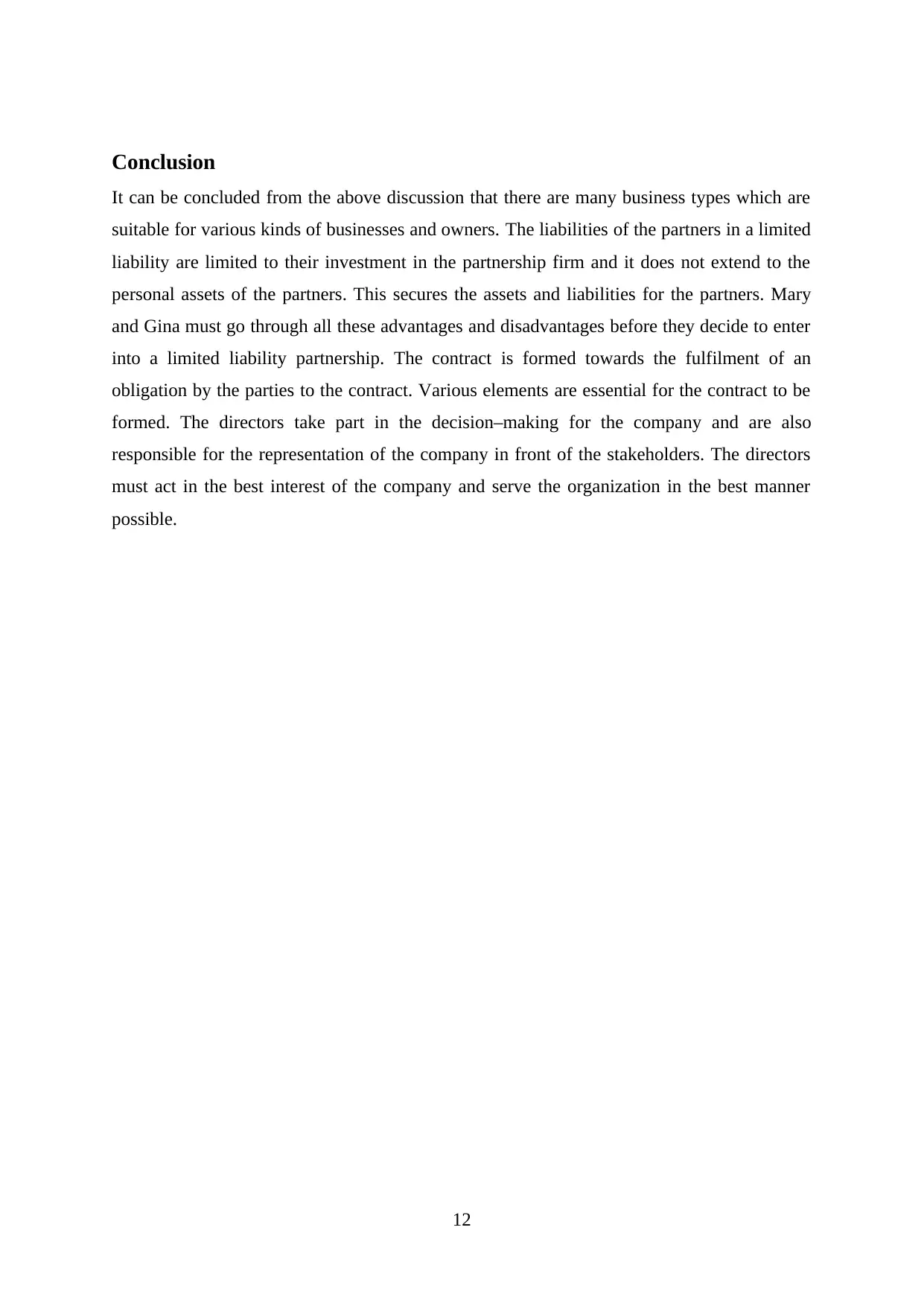
Conclusion
It can be concluded from the above discussion that there are many business types which are
suitable for various kinds of businesses and owners. The liabilities of the partners in a limited
liability are limited to their investment in the partnership firm and it does not extend to the
personal assets of the partners. This secures the assets and liabilities for the partners. Mary
and Gina must go through all these advantages and disadvantages before they decide to enter
into a limited liability partnership. The contract is formed towards the fulfilment of an
obligation by the parties to the contract. Various elements are essential for the contract to be
formed. The directors take part in the decision–making for the company and are also
responsible for the representation of the company in front of the stakeholders. The directors
must act in the best interest of the company and serve the organization in the best manner
possible.
12
It can be concluded from the above discussion that there are many business types which are
suitable for various kinds of businesses and owners. The liabilities of the partners in a limited
liability are limited to their investment in the partnership firm and it does not extend to the
personal assets of the partners. This secures the assets and liabilities for the partners. Mary
and Gina must go through all these advantages and disadvantages before they decide to enter
into a limited liability partnership. The contract is formed towards the fulfilment of an
obligation by the parties to the contract. Various elements are essential for the contract to be
formed. The directors take part in the decision–making for the company and are also
responsible for the representation of the company in front of the stakeholders. The directors
must act in the best interest of the company and serve the organization in the best manner
possible.
12
⊘ This is a preview!⊘
Do you want full access?
Subscribe today to unlock all pages.

Trusted by 1+ million students worldwide
1 out of 14
Related Documents
Your All-in-One AI-Powered Toolkit for Academic Success.
+13062052269
info@desklib.com
Available 24*7 on WhatsApp / Email
![[object Object]](/_next/static/media/star-bottom.7253800d.svg)
Unlock your academic potential
Copyright © 2020–2025 A2Z Services. All Rights Reserved. Developed and managed by ZUCOL.




